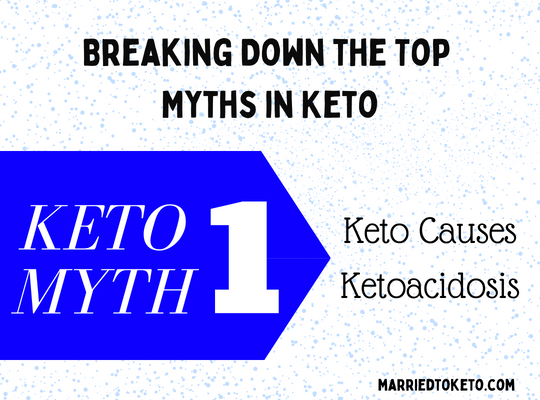Recently, I wrote a blog of the top 10 keto myths. Once I finished the blog, I realized how much there was to say about each one! So, I decided to break each one down into its own blog. The first one on the list is the difference between keto and ketoacidosis.
What is Keto?
Keto is a way of eating where you cut down on the amount of carbohydrates (or carbs) that you eat. Once you get down to about 20 grams of net carbs a day, your body realizes it can’t use carbs as an energy source anymore. This is when you go into ketosis and your body produces ketones, using fat as the energy source. The key with this way of eating is to ensure about 75% of your calories come from fat. About 5% of your calories can come from carbs. The other 20% of calories come from protein,
What is Ketoacidosis?
According to the CDC, ketoacidosis occurs when the body doesn’t have enough insulin to allow blood sugar into your cells for use as energy, so it starts producing ketones to use as energy. This isn’t the case of decreasing carbs. In fact, it happens when you take in so many carbs, your insulin levels can’t keep up. This happens most commonly with Type 1 diabetes, but it can also happen with Type 2 diabetes. Ketoacidosis is extremely dangerous, and can be life threatening.
Why is there confusion between keto and ketoacidosis?
Well, in both cases, ketones are produced by your body. But, with keto, you are deliberately switching your body over to produce ketones. This is done by lowering your blood glucose (i.e. eating fewer carbs). Ketoacidosis happens when your blood glucose levels are high AND you produce ketones.
It’s no wonder that many people with diabetes are scared to do keto. They have been told that if they produce ketones, it can be dangerous and even life threatening. And that’s true – if you have taken in too many carbs.

Why Keto and Ketoacidosis Are Not the Same
Ketoacidosis happens when people have taken in so many carbs that their insulin can’t keep up. This happens most often with diabetics, who have issues around their insulin. Hopefully, most people with diabetes take good care of themselves and their insulin levels, keeping it stable.
The entire point of keto is to keep your carb levels minimal so your insulin levels are stable. You don’t have insulin spikes because you don’t take in sugar, and even natural sugars are limited. With keto, you take in very few carbs and even less sugar. You produce ketones because your body makes the switch and starts burning fat – not because your body is overloaded with carbs.
A Final Thought of Keto and Ketoacidosis
People who have diabetes can shy away from the keto diet because they mix up the way of eating with ketoacidosis. In fact, keto is often recommended as a way of eating for people with diabetes. It helps reduce the body’s need to produce insulin and keeps insulin levels stable.
I’m not a doctor. I can’t tell you that if you have diabetes, you should go on keto. All I can say is that for me, my sugar levels were excellent when I had my last blood tests done. If you follow the keto diet, there should be no way (unless you go wayyyyyyy off plan one day) that your body could fall into ketoacidosis.
Wendy



